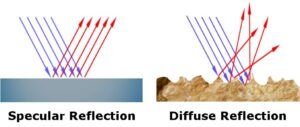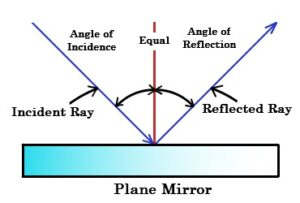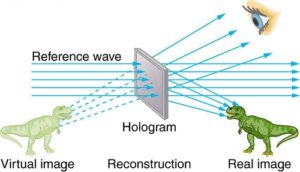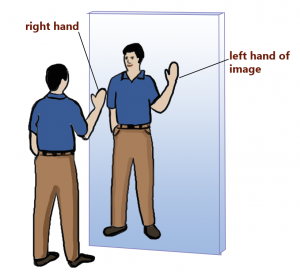LIGHT
An object reflects light that falls on it. This reflected light when received by our eyes, enables us to see things.
REFLECTION OF LIGHT
Reflection of light is the phenomenon of bouncing back of light in the same medium on striking the surface of any object.
There are two types of reflection:
- Regular Reflection or Specular Reflection
- Irregular Reflection or Diffuse Reflection
REGULAR REFLECTION: When the reflecting surface is smooth and well polished, the parallel rays falling on it are reflected parallel to one another, the reflected light goes in one particular direction. This is Regular reflection or Specular reflection see below figure.
IRREGULAR REFLECTION: When the reflecting surface is rough, the parallel rays falling on it reflected in different direction, as shown in below fig. Such a reflection is known as diffuse reflection or irregular reflection.

LAWS OF REFLECTION OF LIGHT
According to the laws of Reflection of light,
(i) The angle of incidence is equal to the angle of reflection, and
(ii) The incident ray, the normal to the mirror at the point of incidence and the reflected ray, all lie in the same plane.
These laws of reflection are applicable to all types of reflecting surfaces including spherical surfaces.

OBJECTS
Anything which gives out light rays either its own or reflected by it, is called an object.
LUMINOUS OBJECTS: The objects like the sun, other stars, electric bulb, tube- light etc. which emit their own light are called luminous objects.
NON – LUMINOUS OBJECTS: The objects which do not emit light themselves but only reflect or scatter the light which falls on them, are called non-luminous objects.
A flower, chair table, book, trees, etc are all non-luminous objects.
IMAGES
Image is an optical appearance produced when light rays coming from an object are
reflected from a mirror (or refracted through lens).
REAL IMAGE
The image which can be obtained on a screen is called a real image. In a cinema hall, we see the images of actors and actress on the screen. So, the images formed on a cinema screen is an example of real images.
VIRTUAL IMAGE
The image which cannot be obtained on a screen is called a virtual image. A virtual image can be seen only by looking into a mirror. The image of our face in a plane mirror is an example of virtual image.

LATERAL INVERSION
When an object is placed in front of a plane mirror, then the right side of object appears to become the left side of image; and the left side of object appears to become the right side of image. This change of sides of an object and its mirror image is called lateral inversion.
The phenomenon of lateral inversion is due to the reflection of light.

